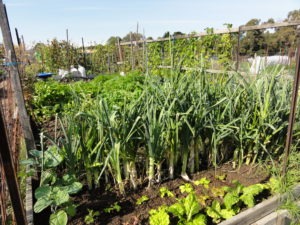Availability of sufficient food is an issue for many around the world. If you are reading this your food supply is probably currently quite secure. Even if you don’t grow much of your own food, the fact that you have email, a computer, time to garden and probably the money to buy seeds and other gardening requirements means that you are not worrying about feeding yourself or your family. However, this is not the case for an increasing number of people, not just in the developing world.
Food security means that people are able to meet their dietary needs and food preferences at all times.It means people are getting fresh, healthy food in adequate amounts to maintain personal health and wellbeing. The federal government’s website on food security states that access to food in Australia places it among the top 5 countries and that 60 million people could be fed from what we produce. Currently, Australia exports more than half of the food it produces and over 90% of fresh produce available to us is produced in Australia. If food security is an issue, enough is either not available or, increasingly, these days, is not affordable.
Future of Australian food security
A report from the Prime Minister’s Science, Engineering and Innovation Council in 2010 stated that “food security is an issue for Australia” because of many challenges:
- An increasing population.
- Decreasing productivity growth of primary industry.
- Increasing land degradation and urban expansion into productive land.
- Climate variability and vulnerability to climate change.
- Increasing dependence on imports of food and products involved in its production which can be affected by events in other countries such as conflict.
- Long transport chains which are of a “just in time” nature and which can spread food contamination quickly and which contribute many food miles to Australia’s greenhouse gas emissions.
Future Directions International, a not-for-profit strategic research institute which researches issues facing Australia is concerned about food security. It concludes that Australia’s food security will increasingly depend on local urban agriculture i.e. food production on urban land in the form of community gardens and home gardening. Urban agriculture is prominent in African and Latin American cities and is slowly increasing in Europe and Australia. Motivations in developed countries, so far, are mainly to obtain chemical-free fresh food rather than addressing food shortages. A survey in 2013 showed that 48 per cent of urban households produced some of their own food. In Melbourne and South East Queensland, government plans recognize a need to increase urban capacity to produce fresh food locally.
They note, however, that there are a range of risks associated with inexperienced and untrained people growing food. SGA will examine these risks and how to overcome them in a subsequent article.
Current food insecurity
Although most of us can prepare for future food insecurity or are already providing significant amounts of food for ourselves, this is not the case for all. The federal government estimated that 2% of our population experience food insecurity and that in some risk groups it could be up to 24%. These groups are socially disadvantaged through lack of, or insufficient, employment to meet family needs, chronic illness, frailty, disability or social or physical isolation. Such groups may also lack knowledge, skills or facilities to prepare or store food.
What is being done about this?
Food Distribution Organisations
A number of not-for-profit organisations are dedicated to sourcing and distributing food to those who cannot provide it for themselves. They provide food for 644,000 people annually including 216,000 children. A worryingly large number of people are not able to be provided for.
Foodbank is the largest of these organization, providing 166,000 meals per day. They rescue surplus edible food from manufacturers, retailers and farmers by collecting it and taking it to warehouses. The food is then collected by more than 2,500 charities and 1,500 schools who distribute it as hampers or prepared meals. Since much food is seasonal or is available unpredictably Foodbank is working with manufacturers to supply staples such as breakfast cereals, tinned fruit and vegetable, pasta and sauce. This type of partnership relies on donations of money and of ingredients, packaging and transport from suppliers and manufacturers.
 FareShare supplies 25,000 free cooked meals from rescued food or donated food with the help of 800 volunteers. Much of the ingredients are fresh, or freshly made and have unpredictable supply. Therefore the kitchen needs to rapidly develop recipes to use them quickly in appetizing meals. The organization has a kitchen garden program, run by volunteers overseen by a horticulturalist, to produce vegetables on vacant unused land. FareShare is always looking for more fertile land and donations of everything involved in food gardening, from tools and gardening clothing to seeds and seedlings.
FareShare supplies 25,000 free cooked meals from rescued food or donated food with the help of 800 volunteers. Much of the ingredients are fresh, or freshly made and have unpredictable supply. Therefore the kitchen needs to rapidly develop recipes to use them quickly in appetizing meals. The organization has a kitchen garden program, run by volunteers overseen by a horticulturalist, to produce vegetables on vacant unused land. FareShare is always looking for more fertile land and donations of everything involved in food gardening, from tools and gardening clothing to seeds and seedlings.
SecondBite is similar to Foodbank and distributes 20,350,000 kg food around Australia annually. Supermarkets, markets, farmers, caterers, wholesalers and events donate surplus food. The organization is supported by the goodwill of participating businesses, volunteers and financial donations.
Individual Action
The above organisations are usually only able to collect large quantities of food e.g. around 50Kg. But you could:
- Make an effort to grow at least some of your favourite vegies, herbs and, space permitting, fruit. Just about all of us can grow something, so give it a go this year. You’ll save money, and you’ll be making a difference.
- Start or join a community garden and connect with others in your community. connected, food secure community is a fantastic place to live.
- Save seeds from your plants, especially those that are heirloom or heritage, and grow them yourself, share with friends or take to a Harvest Swap.
- Join or start a Harvest Swap to establish a network of gardeners who are producing food at home.
- Donate your excess produce or pantry content to organisations such as those below:
Organisations that Gardeners can Participate in
Your local church or school might have drop-in lunch/breakfast programs which welcome donations of food.
 New initiatives are arising to share excess produce at a local level e.g. the innovative Food is Free Laneway, Ballarat which is a bit like a Food Swap except you don’t need to bring anything to be able to take. Similar sharing venues now exist in 15 different locations.
New initiatives are arising to share excess produce at a local level e.g. the innovative Food is Free Laneway, Ballarat which is a bit like a Food Swap except you don’t need to bring anything to be able to take. Similar sharing venues now exist in 15 different locations.
In North West Tasmania, Produce to People collects food from farmers, food suppliers and backyard gardens and gives it to neighbourhood houses, schools and charities.
A social enterprise program which supports the homeless with a focus on youth, STREAT runs cafes, a coffee roastery and catering business which provides opportunities for youth to be trained in hospitality. It works with charities to support youth in other ways. A new project is developing a high-end café and kitchen garden – they welcome donations of fresh food, seeds and seedlings.
Quercus Community Kitchen Garden, established by SGA with support of the Helen McPherson Smith Trust, grows food which, along with food from the Albury/Wodonga FoodShare, is used in the local Community Food Project. This project prepares meals from fresh food and freezes and stores them for weekly distribution to people unable to meet their food needs.
A different Food is Free project started in Austin, Texas, where people are making their front gardens or other spare pieces of land available to grow vegetables and fruit for others.
So to alleviate food insecurity you can get involved in any this type of organisation – or set up your own!
Related Articles:
Garden Journaling – Slow down to tune in.
As we move through the year and our gardens evolve, there's something magical about documenting the journey. Garden journaling is an art that enables…
The Importance of building soil health for a biodeverse, productive garden
Creating a thriving garden that not only sustains itself but also contributes to the broader ecosystem requires more than just sunlight and water.…




